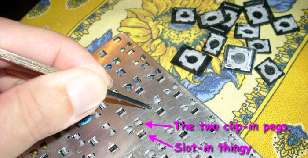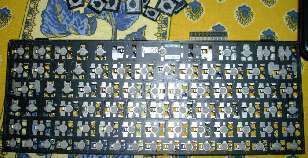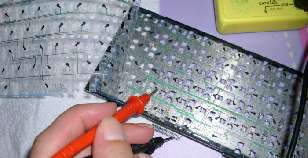Rick's b.log - 2010/08/28
You are 18.219.18.238, pleased to meet you!
Rick's b.log - 2010/08/28 |
|
| It is the 21st of November 2024 You are 18.219.18.238, pleased to meet you! |
|
mailto: blog -at- heyrick -dot- eu
Give Windows some credit, with the language utility on the task bar, switching between keyboard layouts is a doddle.
Anyway... Last weekend I had a number of Qs where they ought not be, then the Caps Lock key took on a mind of its own. And on Tuesday? Half the keyboard died.
So I got a USB keyboard. Ironically twice the size of the eeePC itself. But it works, mostly. The BIOS does not recognise it, which isn't really surprising given that it is a laptop with a built-in keyboard, but this also has the quirky side-effect of meaning you cannot press a key to wake the machine up from standby, though thankfully a quick press of the Power button will do this. Phew!
I am now running Azumi keyboardless (well, with this USB one). The keyboard was, actually, really simple to get out. There are three little clips up the top. Above F1, F6, and Pause/Break. Gently press these back with a jeweller's screwdriver while gently lifting the keyboard with a toothpick under a key. I start with the right and work leftwards. Note the use of the word gently. For attempting anything with a keyboard unit, you'll need the steady hand of a bomb disposal expert and the patience of a saint.
Clips undone, you'll see the keyboard simply tilts forwards and slots in place, but be careful, there's a ribbon cable underneath front-left. Loosen the clip on the motherboard and the ribbon will be easy to remove, the only obstacle being the fold.
This is the point where a normal person would chuck the thing in the bin and unwrap a replacement.
So no, it isn't bin-time just yet...
The first step is to remove the keys. If you flip the keyboard over, you will see that the keys are held in place with three plastic clips. The one on its own cannot be undone as it is a sort of slot-in arrangement. However the part with two side-by-side is actually a set of clap-in pegs. These can be popped out by gently (there's that word again) poking with a blunt-tipped jeweller's screwdriver.
This will leave you with a sort of weird membrane thing with nipples that can be simply lifted off. All it does is provide a springiness to the keys and act as the keypress action.
The next layer is the actual keyboard membrane. It is a finely printed circuit printed onto two layers of plastic. But it gets worse. See the little green bits? Those are layers on top of layers. It's pretty complicated.
The keyboard membrane, if you look closely, works by shorting the tracks on the upper layer against tracks on the lower layer. The pattern of the short-circuit determines which key has been pressed.
See the blue edge? That is a sticky thing designed to keep the membrane together. You will need to gently separate this. The keyboard folds on the left, so you'll want to separate it from the right. But, that's not all. See all those little blue dots? The hundreds and hundreds? Yup... You might find a stiff manilla envelope useful here.
IMPORTANT: The lower layer is affixed to the metal all around where the ribbon passes through. Don't even try to separate this.
Don't try to unfold it on the left, just roll it back. You can get to what you need without risking damaging your membrane.
Now with the keyboard membrane opened up, it is time to wash it with some demineralised water (very important - not tap water). You can get this stuff from supermarkets near where white spirit and such is stocked. It is often used in irons. Apply some to a clean cotton cloth and, you know the G word by now, rub gently to clean up the contacts and the circuitry.
It is best to refit the keyboard base, and the nipple-layer into your computer and try it out without having any of the keys fitted. This way, you can start up Notepad and check the contacts are okay without thinking what it would mean if it isn't fully operational.
This wasn't enough for my machine. There was still a problem that pressing 1 gave a machine unable to tell if I'd pressed 1 or 2. Likewise for other combinations.
Now, this part of the b.log entry is written using the natural eeePC keyboard, having reassembled it (to refit the keys, line up the slot-in and press to click in the double-pin part; if you don't have a keyboard map handy, just start up Notepad and press to see what each key does!). Actually, the second half of the entry was written using the natural keyboard and it's a lot smaller but sooo much nicer than a massive keyboard on top!
I don't know if this work will last a week, a year, or until the end of the computer's life cycle. I may see about buying the replacement keyboard when I have that sort of money available, or perhaps seeing if I can get another eeePC 901 as a backup machine. But for now, today, I don't have that kind of cash free and I'm pleased I was able to rescue the keyboard.
Obviously - this instruction given in good faith, E&OE, no liability, etc. Use your own judgment when attempting repairs on your equipment. And note that some insurance policies might cover you for this sort of thing...
Keyboard woes
I am writing this using an icky French keyboard. Actually, the keyboard itself isn't that bad. It's a really flat thing called the NGS "Classy" (website link, though mine is grey, not orange). The problem? The AZERTY layout. Ick.
It has been humid here, probably the most recent weather to cause a problem given there might be some, you know, tea inside it...
Replacements, however, don't come cheap. The Swedish website I visited (link) did not have an exact parts match, but I asked the guy and he pointed me to a black Windows-logo 901 keyboard, must be pretty standard. Anyway, it's not a bad price. €29,81. Okay, that's more than a tenth of the as-new cost of the machine, but if it's that or nothing... What isn't so good as, with tax, it becomes €37,29 and since it is DHL'd to me, add another €20,46 for shipping.

[how to remove individual keys]
The two larger keys (left Shift and Enter) have little metal things underneath. Note how this fits together for reassembly. The point of this is to provide an even key action if you hit it off-centre.
Oh, and you're on your own with regards the Space bar. As it has both a metal bar and the key clips are in opposition to each other, it's a real bugger to get off.

[inside the keyboard; note that keyboard is upside down]
[the membrane opened, checking the circuit is okay]
My membrane was so sticky that I'm surprised it even worked. That'll be tea with milk and sugar for you!
Once it has been patted dry, wrap some paper towels around the parts and leave it in a warm (not hot, not direct sun) place for three or four days. Yes, days.
Yes, it would. However there are two problems. The first is pure isopropyl alcohol is damned near impossible to obtain as a domestic individual. If a chemist even admits to having it, they'll sell you a thimble-full at a shocking mark-up. I guess this is on some sort of list as being unsuitable to sell to regular Joes, which is somewhat ironic given you can have more fun with a lighter and a can of WD40.
Don't be suckered into "surgical spirit" with words like 70° or 90%. If it is not pure isopropyl, you don't want to be chucking it onto electrical equipment.
The second problem is that alcohol solutions tend not to be overly friendly to various types of plastics (regular petrol will easily dissolve a cheap plastic drinks cup like those ones you can buy in 50s and 100s for a couple of pounds in the supermarket). Not only this, but it is a piece of plastic with metal tracks affixed, and alternative layers providing more complications. Alcohol might be fine, I wouldn't want to risk it...
A careful examination of the membrane showed that in certain places rust had formed, with little tendrils spreading out between the layers of the lower membrane. With a very very careful hand I used a sharp craft knife (eeek!) to slice (aaargh, wtf dude!) through the membrane plastic between the tracks, breaking the unwanted connection. Now the computer could tell the difference between various key combinations.

[refitting keys - slot in and press to click in place.]
Mick, 29th August 2010, 11:41
PS It's a real shame you felt you had to add a disclaimer.Rob, 29th August 2010, 13:46
As for repairing broken tracks .. I seem to recall a discussion about a sort of conductive silver paint one could use in circumstances like this. (actually, I think it was in relation to heated rear windscreens on cars, which are also impossible to solder to..)Rick, 2nd September 2010, 17:02
I have a keyboard lined up from Fleabay, around twenty quid all in, it is somewhat better than the more official spares channel. I'll send off for it in a couple of days. The 'Q' problem is still there (taking out the keyboard and leaving it a quarter hour in the sun (face down) sorts it for a while. While I have the keyboard 'repaired' (using it to write this), it is not 100% and, for the sake of twenty quid, it is silly to continue like this when I can just, you know, replace it!
Yup, it took hours. You know, there's not a whole lot of night life around here! <smirk>
Rob - yeah, rust. It appears to be some sort of iron-based metal in the membrane, maybe copper is too fragile? Mick also mentioned the silver paint, but really I think such things are only useful for times when a replacement is absolutely impossible to find, like maybe some obscure '80s machine... Personally I'd draw the line at attempting repairs of broken tracks.
BTW, just seen I messed up with the pictures and had two of the same. Fixed that.
| © 2010 Rick Murray |
This web page is licenced for your personal, private, non-commercial use only. No automated processing by advertising systems is permitted. RIPA notice: No consent is given for interception of page transmission. |